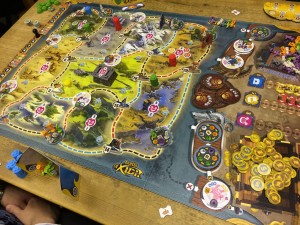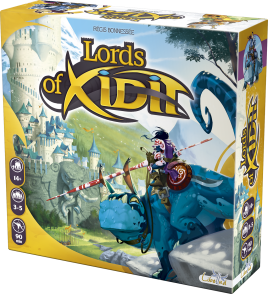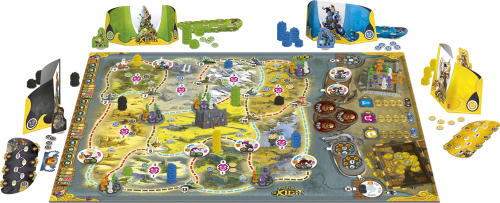Review: Lords of Xidit
Posted by James (admin) on January 30th, 2015
 Lords of Xidit is a medium-weight eurogame whose core mechanic is about programming your moves and actions which results in a mix of short-term decision-making with some longer-term strategies. This allows you to recover if you mess up, or if someone gets in your way (intentionally or by outsmarting you).
Lords of Xidit is a medium-weight eurogame whose core mechanic is about programming your moves and actions which results in a mix of short-term decision-making with some longer-term strategies. This allows you to recover if you mess up, or if someone gets in your way (intentionally or by outsmarting you).
The Game
Players move their character around the land from city to city, recruiting units and defeating threats. At the start of each round, each player programs 6 actions that their character will perform in sequence. There are 5 actions to choose from: move along either the red, white, or blue road from their current city, interact with the city where they are located, or wait. You need to work out which actions you want to perform and where but, as with other action-programming games, you need to work out what your opponents will be trying to do too.
Interacting at a city with a recruitment disc lets you takes the least valuable unit from the disc (the more valuable ones are more rare). Interacting at a city with a threat disc lets you defeat the treat if you discard the required unit types shown in the disc. Successfully defeating a threat lets you pick one of the 3 reward types: gold, bard tokens, or tower sections. Bard tokens are placed in the city’s neighbouring areas which adds an element of area control to the game. Tower sections get placed in a stack at the city but no other player can have a tower in a city if an opponent has one there already.
All 3 types of reward are available from defeating a threat, but the amount of each reward varies. So, you may want bard tokens as a reward but the threat defeated may only give 1 bard token compared to 4 gold or 3 tower sections. So, not only will you need to gain the right unit types to defeat threats on the board, but you also need to compare the different rewards and decide which is the most useful based on the amount, location, and what other players have earned too. This makes for some interesting decision-making.
When all the recruits are taken from a city, or a threat is defeated, a new disc is placed on a different city – each disc is for a specific city on the board. I like that players can see the next couple of discs of both types that will appear and know where they will appear as you can prepare for these. Also, you can even plan the appearance of city discs into your turn (and cause them to happen on purpose) so your actions are timed with their appearance (although another player may mess up your plans, of course).
After every few rounds, there is a census (scoring round) when players simultaneously reveal however many units they want from behind their screens. The amount of each type (colour) is compared separately and the players with the most of each type gain a specific reward, i.e. most orange = 1 gold, most white = 2 bard tokens, etc. I like the gameplay here that you don’t have to show all of your units so you can keep some info about what you hold secret, but at the risk that you don’t show enough to get the bonus.
 The way the winner is decided is an interesting game mechanic. At the start of the game, the 3 reward types are placed in a random order. At the end of the game, players compare each of the 3 reward types – total gold, total tower sections built, and the total value of areas controlled from having bard tokens. To determine the winner, the players compare their amounts of the first reward type and the player with the fewest of this type is eliminated. Then, the second and the third reward types are compared in the same way and, again, the player with the fewest is eliminated each time. After 3 assessments only one player will remain and they are the winner. (In a 3-player game there’s a dummy player, and in a 5-player game two players get eliminated in the first assessment.)
The way the winner is decided is an interesting game mechanic. At the start of the game, the 3 reward types are placed in a random order. At the end of the game, players compare each of the 3 reward types – total gold, total tower sections built, and the total value of areas controlled from having bard tokens. To determine the winner, the players compare their amounts of the first reward type and the player with the fewest of this type is eliminated. Then, the second and the third reward types are compared in the same way and, again, the player with the fewest is eliminated each time. After 3 assessments only one player will remain and they are the winner. (In a 3-player game there’s a dummy player, and in a 5-player game two players get eliminated in the first assessment.)
Thoughts
I really enjoyed Lords of Xidit. I like games with programming gameplay mechanics but, too often, they are frustrating because one mistake spells the end of any chances of winning, and they often take too long to resolve. However, Lords of Xidit flows quickly as the actions are resolved in clockwise order and are simple to resolve; plus, if someone messes up your plan that round, you can meaningfully change your goals/strategy for the next round.
There’s plenty to think about during the game. Programming your move is the core action, but you need to do it based on working out how to gain units with which you can defeat threats that give good rewards in the right places.
Plus, you still need to outwit and outperform your opponents. I liked the tense feel the game gives you when you’ve programmed what you think is a great round but you’re waiting to see if an opponent is going to do that one action you know could totally derail it. Just arriving at a city one turn too late can mean you get a different coloured recruit (because an opponent took one) which means you can’t defeat the threat you’ve programmed to visit. Not only do you need to consider what actions they are likely to perform (factoring in the turn order too) for your short-term programming, but you also need to consider what objectives they are aiming at for their long-term goal too.
The victory system is very interesting as it requires players to work on all 3 objectives, but you only need to not be the worst compared to whoever’s left in each comparison. A player who has masses of gold may be eliminated before they can use it as a deciding factor due not having built enough towers. This system means it’s possible to win without having the single, clear majority in any of the 3 objectives.
The last few turns of the game can contain some analysis paralysis as players weigh up the relative effects when choosing their rewards from eliminating threats – gold is hidden during the game, but towers are open information, as are most of the bard tokens (and calculating the total influence from each area to see who’s doing best/worst takes a bit of time). However, it depends on the players and can be avoided with some simple prodding.
 Physically, the game is very good. The iconography is clear and I like that the ‘number of rounds’ track also shows how the census (mid-game rewards) is assessed and its rewards. The action devices you use to program your moves, with 6 turnable wheels to select each action, are very good too – simple to use and clear. The artwork on the board is nice although some of the colours were a bit neon for my liking; however, it wasn’t too bad and I appreciate it’s a tricky game to represent clearly when so many unique colours are required (5 different units/figures, 3 routes, 3 objectives, 5 players, and 9 regions).
Physically, the game is very good. The iconography is clear and I like that the ‘number of rounds’ track also shows how the census (mid-game rewards) is assessed and its rewards. The action devices you use to program your moves, with 6 turnable wheels to select each action, are very good too – simple to use and clear. The artwork on the board is nice although some of the colours were a bit neon for my liking; however, it wasn’t too bad and I appreciate it’s a tricky game to represent clearly when so many unique colours are required (5 different units/figures, 3 routes, 3 objectives, 5 players, and 9 regions).
Overall, I liked Lords of Xidit a lot as it delivered a fast-paced, programming game with lots of short-term decisions needed to achieve a longer-term plan. It’s actually a relatively simple game too so could be a good stepping stone for gamers who want to progress from playing gateway games to something with a bit more complexity.
You can read more info and the rules on Libellud’s Lords of Xidit page here: bga.me/xidit
James.
[Played with 4 players]


March 11th, 2015 at 3:44 am
I’ve never seen a victory mechanic like that before. Sounds interesting!